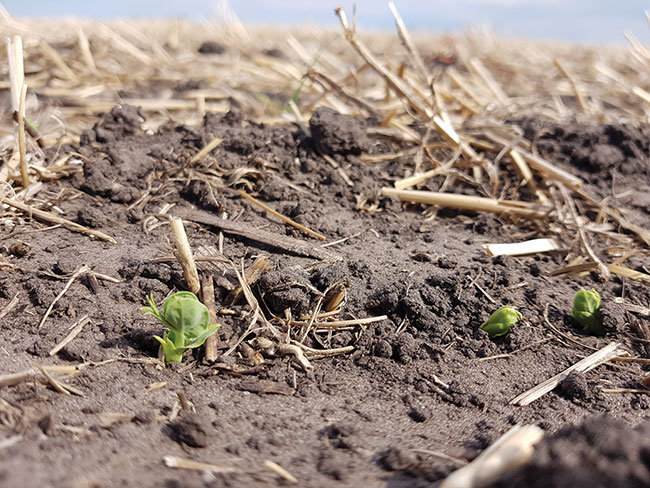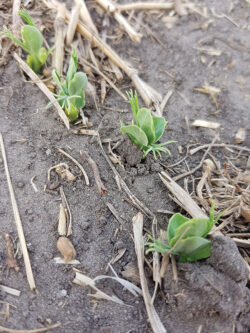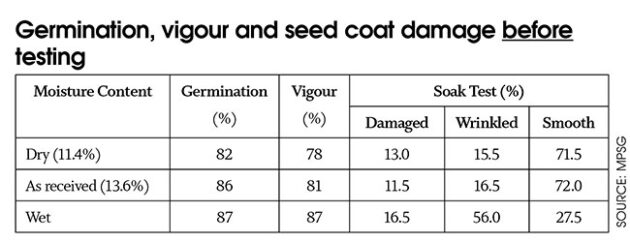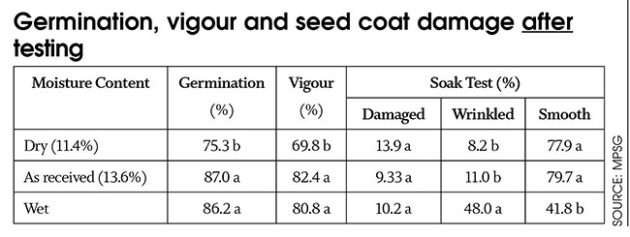
Features
Pulses
Seeding/Planting
Minimizing field pea seed damage in air seeders
Overly dry seed suffered loss of germination and vigour.
April 19, 2023 By Bruce Barker
 Overly dry pea seed resulted in lower germination and vigour after running through an air seeder.
Photos COURTESY OF Laura Schmidt.
Overly dry pea seed resulted in lower germination and vigour after running through an air seeder.
Photos COURTESY OF Laura Schmidt. From the air tank to the opener, field pea seed bounces from manifold to secondary manifolds through hoses and openers before hitting the ground. That means there is potential for seed cracking and damage, which can impact germination, vigour and stand establishment. Manitoba Pulse and Soybean Growers (MPSG) association funded a research project with the Prairie Agricultural Machinery Institute (PAMI) to see how fan speed and seed moisture content impacted germination and vigour.
“As larger seeding equipment has become more common, there was a desire to know if greater fan speeds resulted in increased damage to pea seed and how seed moisture content might impact seed damage,” says Laura Schmidt, production specialist with MPSG. “With this project, we wanted to dive into if manipulating fan speeds played a role in germination and vigour and further explore the effect of pea seed moisture content on survivability. From previous work with PAMI in soybeans, seed moisture content mattered the most in terms of germination and vigour and there was the desire to explore if that was the case in peas as well.”
Schmidt says that over the past few years, a wide range in pea plant stands in fields visited over the last few years has been observed, and most often those plant stands have fallen below the recommended plant stand of seven to nine plants per square foot. In some cases, seeding rates were just lower than they needed to be, she says, but most of the time there was a large range in seeds surviving to establish a plant – anywhere from 29 to 77 per cent.
A 65-ft, 2010 Bourgault Paralink Hoe Drill 3310 with a 6550 cart was used in the PAMI research, representative of air drills used in Manitoba. The drill contained six secondary manifolds, each with 11 openers, resulting in 66 openers across the drill.
Bags were tied to each opener to capture seed and starter fertilizer, and attached so that air could escape the bag to reduce possible back flow. Bags were grouped into “outside, in-between, and centre” sections of the drill to ensure the samples were representative of the entire drill width. A composite sample was taken from each group.

Fan speed did not affect germination or vigour.
Photos courtesy of Laura Schmidt.
The seeding rate targeted a plant stand of 7.4 – 8.4 live plants/ft², and was 222.7 pounds per acre (3.7 bu/ac) for the trials. The fertilizer used was MES15, targeted at a rate of 20 lb P205 lb/ac, and was 59.7 lb/ac of product for the trials.
The trials were stationary, and fan speeds were controlled by hydraulically driven motors. Each trial was run for the equivalent of 0.5 seeded acres with a targeted ground speed of 3.0 mph.
Three fan speeds were compared. The manufacturer recommended fan speed of 4,250 rpm was chosen as the medium speed, with the speed varied by eight per cent lower or higher resulting in a lower speed of 3,900 rpm and a high speed of 4,600 rpm.
Three seed moisture contents were also compared. AAC Carver yellow pea seed with a moisture content of 13.6 per cent represented the middle range of moisture content. This seed was split into three samples. One sample was dried to 11.4 per cent and the other sample was wetted up to 15.1 per cent seed moisture. These three samples were tested for germination and vigour prior to the tests to establish baseline controls to compare to. A soak test was also conducted prior to testing to assess seed coat damage for damaged, wrinkled and smooth seeds.
“Seed coat damage was assessed via a soak test, where you soak seeds in water and then count the number of swollen seeds with damaged seed coats,” says Schmidt. “It is a test that farmers can easily do on their own farms to assess what percent of seeds are showing signs of seed coat damage so you can account for them when calculating your seeding rate.”
No effects with fan speed
Somewhat surprisingly, fan speed did not significantly impact germination or vigour. However, this result was similar to another MPSG-funded study by PAMI, that found fan speed did not affect wheat, canola or soybean germination.
“Though differences in fan speed did not affect the seed quality, manufacturer-recommended speeds are suggested to maintain productive performance to reduce the risk of plugging at low fan speeds and improve the potential for more accurate seed distribution at recommended speeds versus high speeds,” says Schmidt.
There were also no significant differences between the outside, in-between and middle locations.
Overly dry seed lost germination and vigour
Seed that had been dried down to 11.4 per cent moisture content suffered a significant loss in germination and vigour, dropping germination to 75.3 per cent and vigour to 69.8 per cent. This would have a larger impact on stand establishment.
These results were also similar to the previous PAMI trial where soybean, wheat and canola seed moisture contents of eight, 10 and 13 per cent were compared. Soybeans at 13 per cent seed moisture had 3.6 per cent higher germination than seed at eight per cent.
These results indicate that initial moisture content, before running the seed through the drill, is an important factor for maintaining seed quality and establishing a successful crop,” says Schmidt. “Pay close attention to proper storage and to monitor pea seed moisture by moving the grain during storage, as necessary. Ensure seed moisture content is at the recommended level to maintain seed germination, vigour and seed coat quality.”

